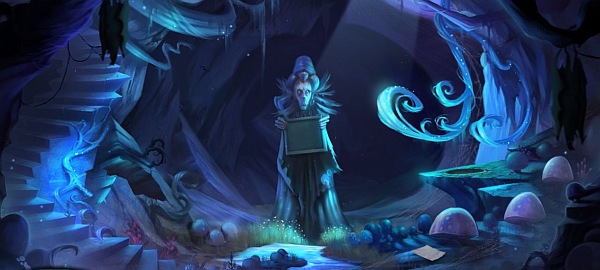Wot I Think: Drawn - Trail Of Shadows
Finger painting
While too many people will turn away from a game like Drawn, simply because of its "casual" appearance, it's a mistake. The previous two Drawn games have been been remarkably good, and with a third out today these are the sorts of adventure games we should be caring about. Does the third, Drawn: Trail Of Shadows, live up to the reputation of the series? I've finished it so am pretty much the right person to tell you Wot I Think.
The Drawn games occupy a peculiar space. Created and distributed by Big Fish games, they should really be “casual”, and somewhat throwaway. (The site releases a game every day.) They’re then presented, from the opening menu to the entire design, as a kids’ game, with both a child protagonist and friendly, colourful cartoon worlds. And at first glance you’d think they’re a hidden object game. There’s little immediately apparent that would lead you to understanding what Drawn is trying to be.
And indeed there’s little apparent by their ending that leads you to understand what Drawn is trying to be. Three games into the series, each exquisite and splendid, and I still have absolutely no idea what they really are. They’re generally very easy, and where they’re not there’s giveaway in-game hints, such that you’d think they’re aimed at a casual market. They’re presented as narrated storybooks and living paintings of fairytale worlds, such that you’d think they’re aimed at children. And you spend a good deal of the time scavenging for objects on the screen. And yet they’re none of those things, and they’re dark.
If anything, Drawn understands what it is to be a fairytale, because they occupy the same blurred space. Not the sanitised storybook versions, but the Cinderella and Red Riding Hood as they were originally written – fantasy stories, ostensibly for children, with brutal hearts.
The third game, Drawn: Trail Of Shadows, makes things even more confusing with its narrated structure. Seemingly the character from the first two games is now being read a story by her grandfather, about a boy who shares her ability to have his paintings come to life. And he, as does everyone with such a skill, makes the mistake of painting an evil wizard. The wizard comes to life, kidnaps the boy, and plans to use his power to paint out the Sun.
Which is the drafted-on-a-napkin reason to justify another voyage through exceptionally gorgeous screens, packed with puzzles and peculiarities.
It’s one of those games that’s such an incredible amount of pleasure to play, but pretty hard to talk about afterward. Not for fear of spoiling something, but rather the lack of anything to spoil. It’s a collection of puzzles, strung beautifully together by a loose tale of magical paintings, with an internal Möbius logic of that which is created coming to life.
(Actually, I there are a couple of exceptions - there is the sequence where you play as Queen Iris, as a chalk-drawn videogame character, along with 8-bit music, and there's the game of croquet against the paper piper.)
Your task is to defeat the wizard and rescue the boy. But who you are isn’t explained – as before you’re the Stranger, who also seems to share the ability to craft living pictures. So you’ll face a few scenes at a time, each containing elements needed for completing the collection of puzzles, often one cascading into the next as you find the coin that releases the shard that completes the disc that unlocks the gem, and so on.
As with the second game, it contains a pop-up book, this time better woven into the structure. As you progress through the wizard-corrupted world the boy had painted, restoring the original brightness and joy, new pages are added to the book which both reveal puzzle solutions while containing more of their own. And, it’s stunning. Absolutely stunning. Pulling on tabs causes the paper-crafted book to reveal its secrets, with all the pleasure of a real-world pop-up book, and then magic on top. Playing with the book provides obscure clues and references to the currently available screens offer opportunities to progress, as well as acting as the storybook for the adventure.
Then outside the book, using found paintbrushes, crayons and so on will inevitably cause something to burst into life. Solving puzzles causes explosions of colour, the world rippling and reanimating itself with remarkable flair. It’s properly magical.
And at the same time, it’s fairly pedestrian in terms of what you’re actually doing. Most of the puzzles are very familiar, and themes like the Three Wise Monkeys are achingly obvious. A few of the puzzles are properly satisfying to solve, but more often you’re just dropping found shapes into the screen and watching it do pretty things.
But for me, those pretty things prove enough. It won’t last you more than two or three hours, or faster if you’re not taking your time to enjoy the scenery. Which you really should.
The hint system also deserves some credit. It’s extraordinarily context sensitive, always exactingly specific to any of the disparate elements you may have already done, and while not subtle, at least doesn’t just give everything away first time. But get stuck, likely because you haven’t found a small object somewhere, and it’ll prompt you to go take a closer look nearby.
Oh, and that darkness. While the overall story is ultimately a positive one, it’s pretty creepy along the way. Not for adults, but I’d certainly want to think twice before letting a little kid play it alone, despite its family-friendly appearance. It gets pretty ghoulish in places.
The game is out to Big Fish members today, and to the rest of the world tomorrow. Their games usually cost around £8, which here would be money well spent.







